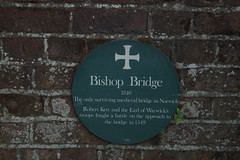Duke John Dudley
.jpg?width=250)
.jpg?width=250)
Duke John Dudley
(1504-1553)
1st Earl of Warwick (1547-1553) and 1st Duke of Northumberland (from 1551)
Commemorated on 1 plaque
Bishop Bridge 1340 The only surviving medieval bridge in Norwich. Robert Kett and the Earl of Warwick's troops fought a battle on the approach to the bridge in 1549.
Low wall on side of bridge facing Riverside Road, Norwich, United Kingdom where they fought (1548)

